
Original Link: https://www.anandtech.com/show/2414
Intel Mobile Penryn Benchmarked: Battery Life Improves Again
by Anand Lal Shimpi on January 7, 2008 12:00 AM EST- Posted in
- CPUs
We’ve been through this before. Every year we get an update to Centrino, and every year the outcome is pretty much the same: equal or better performance, coupled with longer battery life. It’s Moore’s Law in action, transistors switch faster, they get smaller and thus Intel’s engineers can do more with them to not only improve performance but reduce power as well. The end result is that each year we have to evaluate whether or not buying a new laptop makes sense.
The last Centrino update brought faster FSB speeds courtesy of the Mobile 965 Express chipset, slightly faster CPU speeds, some additional power saving technology, and Intel’s controversial Turbo Memory. Despite what was looking like a potentially major improvement in the Centrino platform (mostly because of Turbo Memory), the end result was a fairly lackluster update to Centrino. It wasn’t bad, it just wasn’t much to get excited about.
The one thing we did say would happen however was that at some point, Santa Rosa (the current Centrino platform) would be updated to support Penryn. That update happens today.
As a simple CPU change, this year’s update is far simpler - it’s all in the processor. Starting this month, Intel will begin shipping its first 45nm mobile processors based on the Penryn core. On the desktop you’ll remember that Penryn offered mild performance improvements over Conroe, but in the mobile space the reduction in power consumption should translate directly into longer battery life and cooler running notebooks.
There are five mobile Penryn cores being introduced today, they are listed below:
All of the chips run at frequencies we’ve already had from current Merom based Core 2 Duo designs. They are all dual core with either 3MB or 6MB of L2 cache shared between the cores. We only have a 6MB L2 part to play with, so it’s tough to say how the 3MB cores will compete at this point.
The new Core 2 Duo T9000 and T8000 series work in modified Santa Rosa platforms, using the same mobile 965 chipset. As long as there is motherboard support, you can use a mobile Penryn (similar to the situation on the desktop).
There should be an obvious performance increase from these new mobile Penryn chips, but the more interesting impact should be on battery life. Mobile Penryn offers two technologies that don’t exist on the desktop chips, one of which is targeted specifically at increasing battery life.
Mobile Penryn supports a deeper sleep state when a core is idle, allowing the chip to go into a near-reset state with only the absolute minimal circuitry powered. The other mobile-specific feature is Intel’s Dynamic Acceleration Technology, which we will discuss and test later in today’s article.
Increasing Battery Life: It’s the Centrino Way
Intel sent us two Dell Latitude D630 notebooks, identically configured, with one variable: the CPU. In one D630, we had a Core 2 Duo T7800, which is a Merom based chip running at 2.6GHz with an 800MHz FSB and a 4MB L2 cache. The other D630 came equipped with a new 45nm Core 2 Duo T9500, also running at 2.6GHz/800MHz but with a larger 6MB L2 cache.

The CPU-Z shots will show that our T9500 CPU ran at 1.15V instead of the 1.225V of the T7800; a reduction in voltage translates directly into a reduction in power consumption of course, meaning longer battery life in a notebook. The question we had was: how much?
Merom:
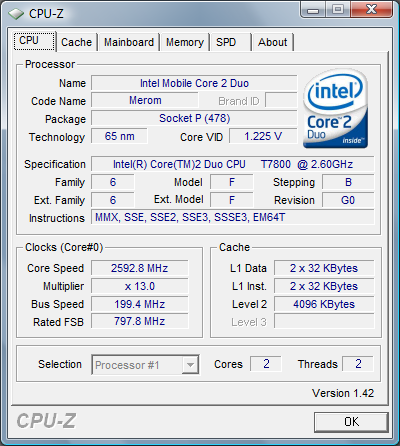
Penryn:

While the CPU is one of the single most power hungry components in a notebook, there are other power hogs as well. The display being one of the most obvious, but other components like the memory, hard drive, chipset and integrated graphics all contribute to the generally mediocre battery life you find in modern day notebooks. All of these power hungry components eat away at that stored energy, so how much could an evolutionary reduction in power actually bring?
To find out if we turned to MobileMark 2007, the latest battery life measurement tool from BAPCo. The MobileMark 2007 suite consists of three individual benchmarks: the Productivity 2007 test, the Reader 2007 test and the DVD playback test.
The Productivity 2007 test mimics what happens in the SYSMark 2007 Productivity test, the only difference being that MobileMark focuses on how long the battery will last, not how fast the system can perform.
We configured both systems identically, LCD brightness was set at three levels down from the maximum and Vista power management settings were set to balanced. To no one’s surprise, the Core 2 Duo T9500 managed to outlast the T7800; it was the margin of victory however that was most surprising.
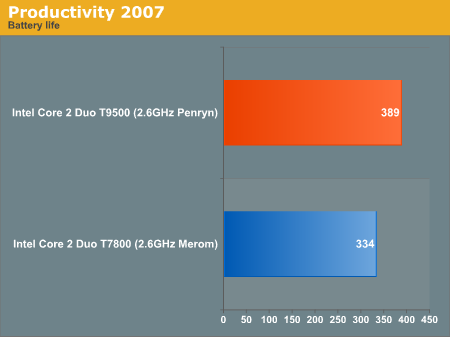
The T9500 lasted an extra 55 minutes, or an increase of almost 16.5% in battery life. We were concerned that the Productivity test over emphasized the impact of Penryn on battery life, so we turned to the other tests in MobileMark.

The Reader 2007 test is mostly idle time, simulating a user reading through documents on a notebook. Despite the very light load, battery life went up 5.6% or a total of 23 minutes on the Penryn system compared to the older Merom based T7800. While not nearly as dramatic as the Productivity 2007 test, the Reader benchmark shows significant improvement especially when you take into account that the only change here is the processor.

The DVD playback benchmark measures battery life while, you guessed it, playing back a DVD. While we don’t even want to begin to think of what battery life would be like playing back a HD-DVD or Blu-ray movie, regular DVDs are still quite manageable. The move to 45nm gave us an extra 18 minutes of battery life when playing back a DVD, an increase of 7%.
While the Productivity results may be a bit extreme, we believe it would be safe to say that the mobile version of Penryn can easily improve battery life on the order of 5 - 10% over an identically configured Merom/Santa Rosa system. Under very specific cases, especially if you’re looking at applications where Penryn is significantly faster than Merom (e.g. SSE4 optimized apps), battery life can improve even more dramatically
Herein lies the strength of these yearly Centrino updates; these increases in battery life will come at no additional cost to the end user. Dell will begin shipping its D630 notebooks with these Core 2 Duo T9500 processors starting in February, at no price premium compared to its current D630 lineup. The T9500 will simply replace the T7800 as the 2.6GHz processor option.
Mobile Penryn vs. Merom: Performance
What about raw performance? MobileMark 2007 does measure performance during the course of running the Productivity 2007 suite:
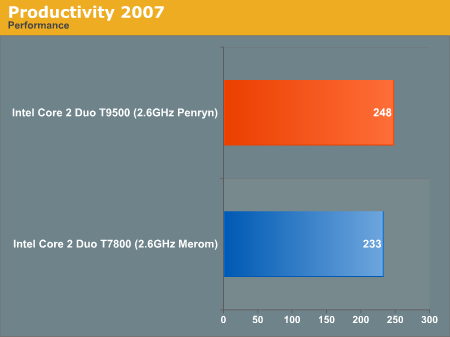
With a 6.4% increase in performance, the mobile Penryn saw a 16% increase in battery life. Remember that when you’re talking about running on battery power, being able to complete tasks faster can mean better overall battery life. The quicker a system can finish its work and move down to an idle state, the better.
Looking at our usual metrics, the Penryn based Core 2 Duo T9500 is still marginally faster than its Merom based predecessor across the board. SYSMark 2007 shows an overall increase of around 4.5%, with individual benchmarks showing an improvement in the 1 - 8% range.
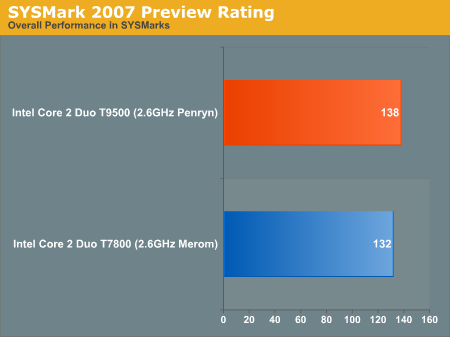
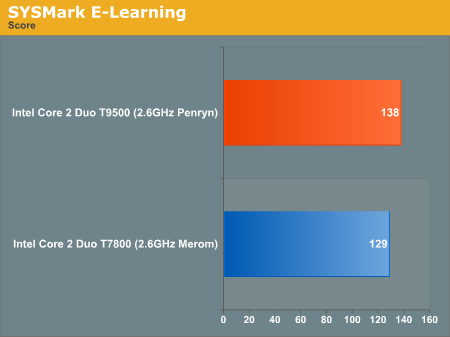
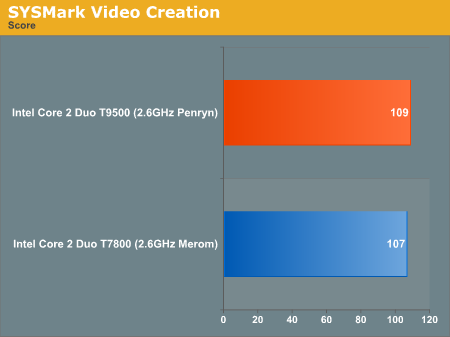
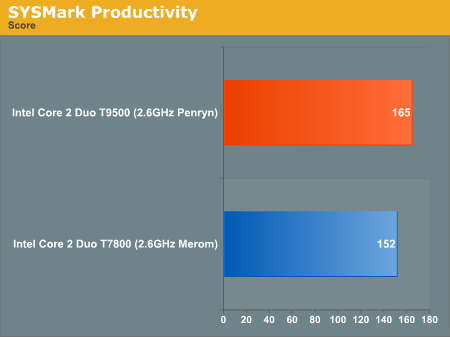
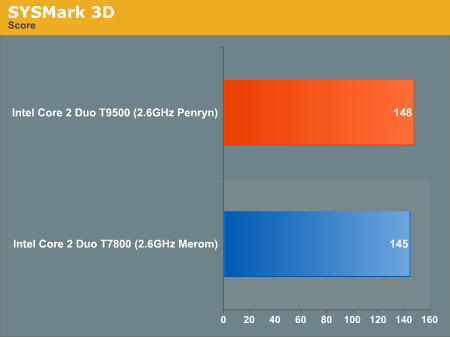
Media encoding performance is slightly better on the T9500, with our DivX and x264 tests completing 4.7% and 2.8% faster, respectively. Again, we don’t see an earth shattering improvement, but when you keep in mind that we can even talk about a performance improvement in the same breath as an improvement in battery life, we can’t really complain.
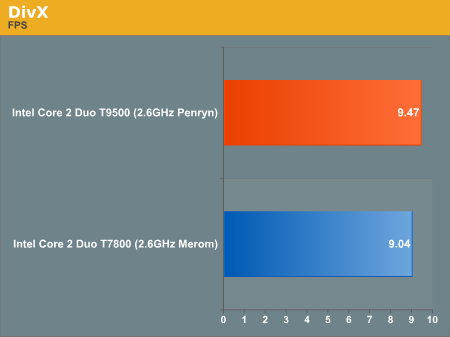
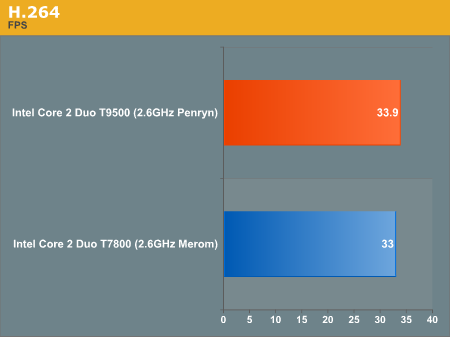
We ran a quick spotcheck on 3D rendering performance using Cinebench R10:
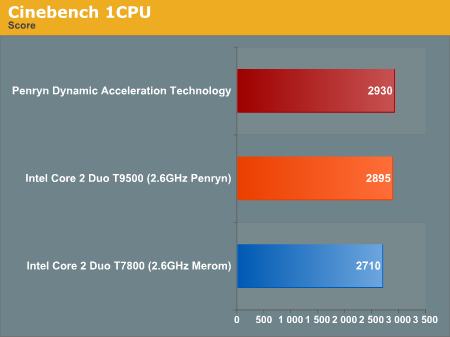
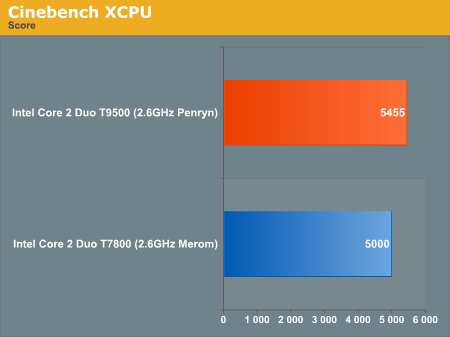
The single core tests show Penryn with a 6.8% performance advantage, while the multi-threaded benchmark grows that to 9.1%. Since Penryn has a 50% larger L2 cache, sharing data between the cores becomes a little easier and thus we see a small boost in the multi-threaded scaling factor.
Gaming benchmarks were out of the question given that our D630s shipped with Intel integrated graphics, but even armed with discrete graphics we’d expect Penryn to just slightly edge out Merom.
Testing Intel’s Dynamic Acceleration Technology
When Penryn was announced Intel promised a feature that sounded kind of interesting. The idea was that when running single threaded applications, a mobile Penryn would use the extra thermal headroom created by having a completely idle second core and increase the clock speed of the working core.
The performance boost would amount to nothing more than a single speedgrade (2.8GHz on our 2.6GHz chip), but the impact would be that you wouldn’t sacrifice any single threaded performance even on a multi-core CPU. One of the tradeoffs of building a dual-core CPU over a single-core is that you can’t generally hit clock frequencies that are as high, this technology gets around that.
We were skeptical about how the technology would work when we first heard about it. OSes like Windows Vista bounce threads from one core to the next, so a single core is never allowed to be completely idle for too long. Regardless, we wanted to try Intel’s “Dynamic Acceleration Technology” to see if: 1) we could get it to work and 2) if it made a difference.
Just as we suspected, getting it to work even while running a single threaded application was virtually impossible. We used CPU-Z to monitor clock speed while running single threaded applications, and our clock frequency never jumped above 2.6GHz. It wasn’t until we forced the processor affinity of an application to a single CPU core that we could actually see Intel’s DAT in action.
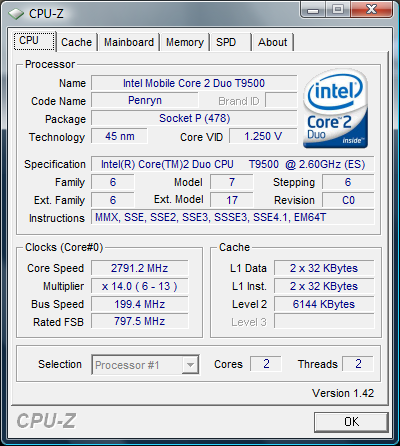
Even when enabled however, the impact was far less dramatic than you’d think. The working core will only increase its operating frequency as long as it has the thermal headroom to do so, which at times may only be for a matter of a second or two. When running the single-threaded Cinebench test our T9500 would increase its clock speed to 2.8GHz but only for very short periods of time. The result was a 2.6GHz CPU that every now and then ran at 2.8GHz, and the increase in performance reflected this.
With a 1.2% increase in performance due to Intel’s DAT, we can’t really get excited about this technology. It’s very rare that it will be working, and when it is the 7.7% increase in clock speed just isn’t enough to increase performance significantly at all. It looks like Intel’s DAT is more of a gimmick rather than something to get excited about.
SSE4 on the Go
Obviously one of the strengths of the Penryn architecture is its SSE4 support. We ran Intel’s TMPEGEnc benchmark, which does take advantage of SSE4 during a movie transcode, and the performance gap widened:
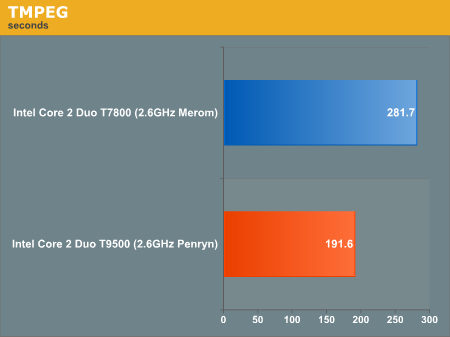
The mobile Penryn based system, because of its SSE4 support, can complete the encoding test in 31% less time than the Merom system. The impact of SSE4 is even more pronounced on the mobile side because of the fact that the mobile chips are already so starved for bandwidth.

The performance gap widened when running a SSE4 optimized VirtualDub 1.7.2 DivX encode, here Penryn would offer a greater than 40% increase in performance.
These SSE4-optimized situations are far more rare than the 1 - 8% increases we saw elsewhere, the point being that should application support develop, Penryn could do much better. Honestly though, we don’t expect a critical mass of SSE4 applications anytime soon, these sorts of things take a long time to materialize.
Final Words
Another day, another dollar, another year, another Centrino. This processor-only update to Santa Rosa actually interests us more than what we saw last year with the introduction of the Santa Rosa platform.
This year's Centrino update is much more back to the basics: performance goes up, as does battery life, and Intel does it all at no additional cost to the end user.
Possibly because it was a ultra-high-end only launch, but Penryn on the desktop just didn't seem nearly as exciting as mobile Penryn. Here the benefits are even more tangible; by keeping clock speeds the same and using the improvements of Intel's 45nm transistors to lower the voltage, Intel is able to reduce power consumption to a measurable degree in a notebook using mobile Penryn.
Current Santa Rosa owners don't really have any burning need to go out and upgrade their systems, but if you were thinking about buying a new laptop you might as well hold off for another month so that these Penryn based systems can hit the streets.
If you have an aging Centrino notebook, now would be a good time to upgrade. We suspect that the timing of Intel's mobile Penryn announcement may have something to do with the fact that Apple will be holding its MacWorld conference next week.








